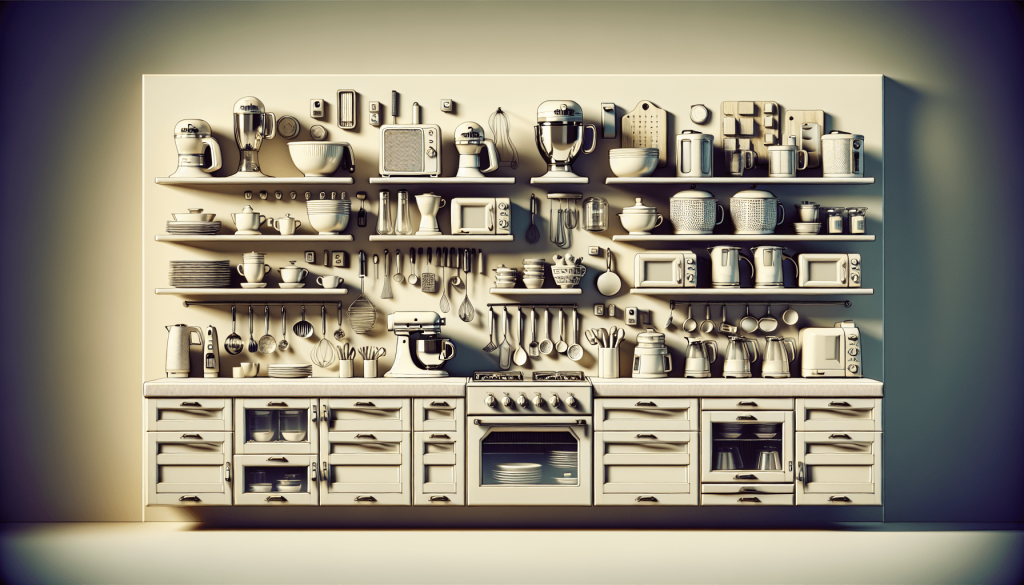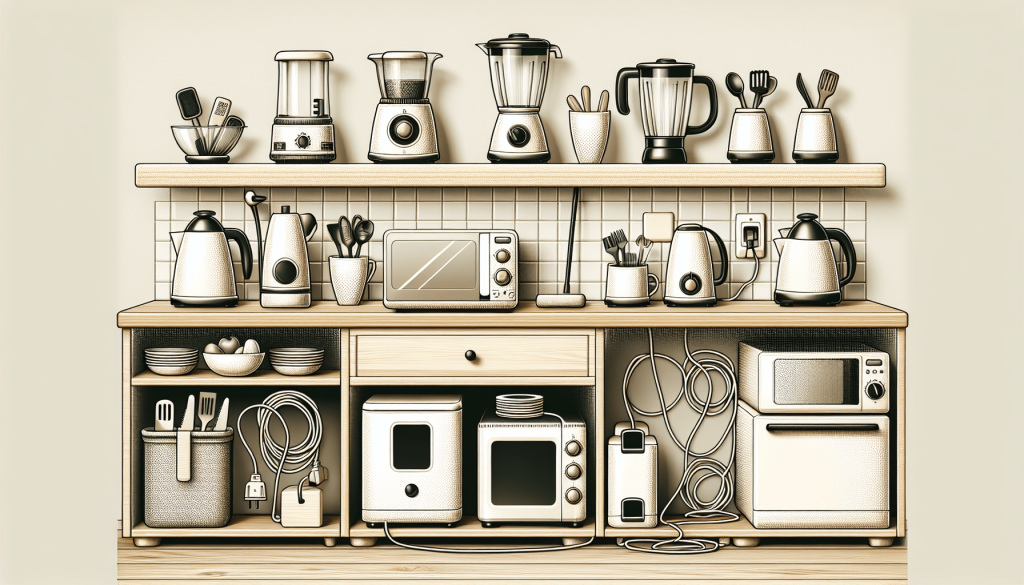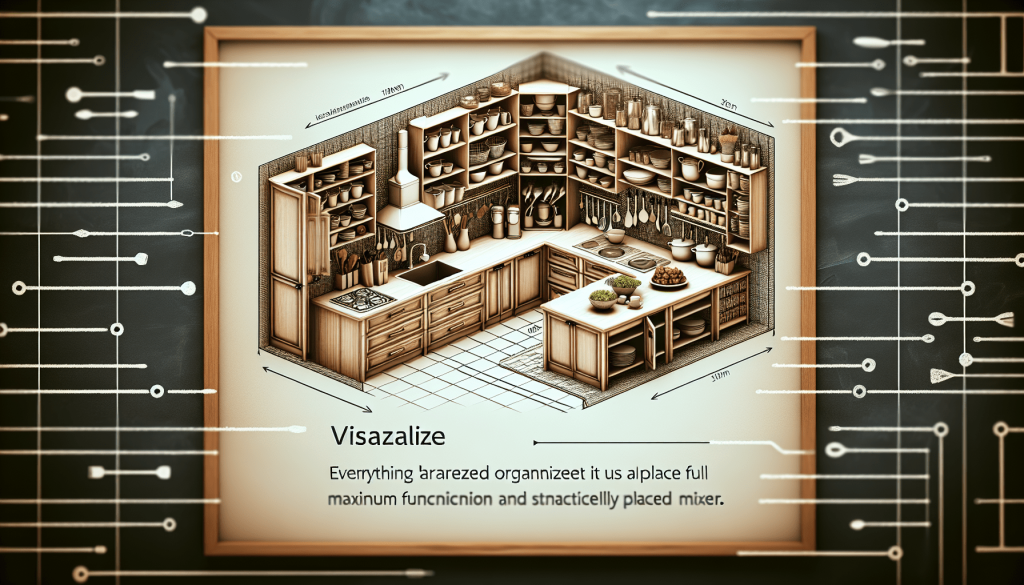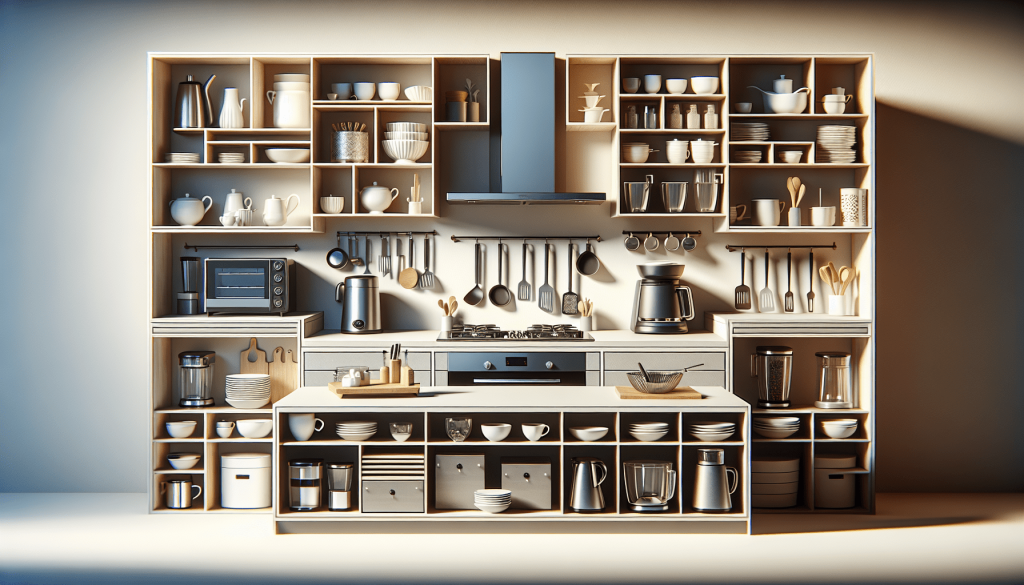In this article, you will find a wealth of expert advice on how to effectively organize your kitchen appliances. Whether you have a small kitchen with limited space or a larger one with plenty of storage options, having a well-organized setup can make all the difference in your daily cooking and meal prep routines. Discover practical tips and clever storage solutions that will help streamline your kitchen and ensure your appliances are easily accessible when you need them most. Say goodbye to clutter and hello to a more efficient and enjoyable cooking experience.

Categorize your appliances
Categorizing your kitchen appliances is an essential first step towards creating an organized and efficient kitchen space. By grouping appliances based on their function, you can easily locate the items you need when preparing meals, saving you valuable time and effort.
Group appliances by function
Start by categorizing your appliances according to their function. For example, you can create separate groups for cooking appliances, such as microwaves, ovens, and stovetops, and another group for food preparation appliances, such as blenders, mixers, and food processors. By keeping similar appliances together, you can streamline your cooking process and avoid searching through cluttered cabinets or drawers.
Separate small appliances from large ones
In addition to grouping appliances by function, it is also useful to separate small appliances from larger ones. Small appliances, such as toasters, coffee makers, and electric kettles, are often used more frequently and are best stored on countertops or in easily accessible cabinets. On the other hand, larger appliances, such as slow cookers and standing mixers, can be stored in lower cabinets or on dedicated shelves to free up valuable countertop space.
Consider frequency of use
When categorizing your appliances, consider their frequency of use. Place frequently used appliances within easy reach to avoid unnecessary bending or reaching. For example, keep your trusty coffee maker or toaster in a convenient spot on the countertop, while appliances that are used less often, such as a bread maker or juicer, can be stored in higher or harder-to-reach areas. This way, you can optimize your kitchen’s functionality and save time in your daily routine.
Create dedicated storage zones
One of the key principles of an organized kitchen is creating dedicated storage zones for your appliances. By designating specific areas for each appliance, you can easily locate them when needed and maintain a clutter-free environment.
Designate countertop space
Start by designating countertop space for your most frequently used appliances. These can include items like your coffee maker, toaster, or blender. Keep in mind that while it’s important to have easy access to these appliances, cluttering your countertops excessively can make your kitchen feel cramped. Be mindful of the available space and prioritize the appliances you use on a daily basis.
Assign cabinet or pantry shelves
Utilize your cabinet or pantry shelves to store appliances that are not used as frequently. Organize these shelves by categories, such as baking appliances, cooking appliances, or specialty appliances. Utilizing shelf dividers can also help to create separate sections within your cabinets and keep everything neat and organized.
Utilize drawer dividers or trays
For smaller appliances or accessories, such as hand mixers, measuring spoons, or knife sets, consider using drawer dividers or trays. These can help keep everything in place and prevent items from getting mixed up or lost in the drawer. Additionally, using dividers can make it easier to locate specific items and maintain an organized and clutter-free drawer.
Maximize vertical storage
Making the most of your kitchen’s vertical space is key to optimizing storage and keeping your appliances organized and easily accessible. Consider these strategies to maximize vertical storage in your kitchen.
Install wall or cabinet-mounted racks
Wall or cabinet-mounted racks are a fantastic way to utilize vertical space in your kitchen. These racks can be used to store small appliances, such as mugs, spice jars, or even cookbooks. By mounting the racks on empty wall space or the inside of cabinet doors, you can free up valuable shelf or countertop space, making your kitchen more organized and functional.
Use hooks or magnetic strips
Hooks and magnetic strips are versatile storage solutions that can be easily installed on walls or inside cabinets. Hooks can be used to hang pots, pans, or utensils, while magnetic strips are an excellent option for storing knives or metal utensils. These alternatives not only maximize vertical space but also provide easy access to frequently used items, reducing clutter and promoting efficiency in the kitchen.
Utilize vertical space inside cabinets
Don’t forget to utilize the vertical space inside your cabinets. Adjustable shelf inserts or stackable shelves can help you make the most of the available space. By creating multiple levels, you can store appliances or dishes more efficiently, avoiding unnecessary stacking and minimizing the risk of items falling or getting damaged.
Arrange appliances strategically
Once you have designated storage zones and maximized vertical space, it’s important to arrange your appliances strategically within these areas. By considering factors such as accessibility, workflow, and ergonomics, you can create a kitchen layout that promotes efficiency and ease of use.
Place frequently used appliances within easy reach
When arranging your appliances, prioritize accessibility. Keep frequently used appliances, such as your kettle, toaster, or blender, within easy reach on the countertop or in easily accessible cabinets. This way, you can quickly grab them whenever needed without having to struggle or waste time searching through cluttered areas.
Consider workflow and ergonomics
Take the time to consider your kitchen’s workflow and how you move around the space when preparing meals. Arrange your appliances in a way that aligns with your natural movements and eliminates unnecessary steps. For example, store your cutting board and knives near the area where you do most of your food prep, and keep your cooking appliances close to your stove or range.
Store heavy appliances on lower shelves or in lower cabinets
When it comes to heavier appliances, such as stand mixers or food processors, it’s wise to store them on lower shelves or in lower cabinets. This avoids the risk of strain or injury from lifting heavy items from higher shelves. Keeping heavier appliances at a more accessible height also ensures that you can easily retrieve them when needed and safely put them away after use.

Utilize storage containers or bins
Using storage containers or bins can be a game-changer when it comes to organizing your kitchen appliances. They not only keep your appliances neat and tidy but also help maximize storage space and make items more easily visible.
Opt for clear containers to easily see appliances
When choosing storage containers or bins, opt for clear options. Clear containers allow you to easily see the contents inside, making it convenient to locate a specific appliance without having to open multiple containers. This saves time and eliminates the frustration of searching through opaque containers or boxes.
Label containers for quick identification
To further enhance organization and efficiency, label your storage containers or bins. This simple step makes it effortless to identify the contents of each container at a glance. You can use adhesive labels, a label maker, or even handwritten labels, depending on your preference. Labeling ensures that you can quickly find the appliance you need, even if you haven’t used it in a while.
Stackable containers help save space
Consider using stackable containers to optimize storage space in your cabinets or pantry. Stackable options allow you to utilize vertical space effectively, reducing clutter and freeing up room for other items. With stackable containers, you can store multiple appliances neatly in a smaller area, ensuring that everything has its designated spot.
Implement an appliance rotation system
An appliance rotation system is an excellent strategy to prevent clutter and keep your kitchen appliances organized. By rotating appliances based on their usage frequency, you can ensure that only the items you need are easily accessible while keeping less frequently used appliances stored away.
Rotate appliances based on usage frequency
Start by assessing the frequency with which you use each of your appliances. Sort them into categories based on their usage, such as daily, weekly, or occasional. Keep the daily appliances within easy reach, while the weekly or occasional ones can be stored in less accessible areas.
Store less frequently used appliances in harder-to-reach areas
As mentioned above, appliances that are used less frequently can be stored in harder-to-reach areas. This can include higher shelves or the back of cabinets. By keeping these appliances out of the way, you can ensure that your kitchen remains clutter-free and that you have ample space for the items you use on a regular basis.
Regularly assess and rotate appliances to prevent clutter
To maintain an organized kitchen, make it a habit to regularly assess your appliances and rotate them as needed. As your cooking needs or preferences change, some appliances may become less relevant, while others may become more useful. By regularly evaluating and rotating your appliances, you can prevent clutter from accumulating and ensure that your kitchen stays organized and functional.

Consider built-in or concealed storage
Built-in or concealed storage solutions can be a game-changer when it comes to organizing your kitchen appliances. These options not only keep your appliances out of sight but also contribute to a seamless and streamlined aesthetic in your kitchen.
Install appliance garages
Appliance garages are a popular choice for concealing countertop appliances. These built-in cabinets or units can house appliances such as toasters, blenders, or coffee makers, and can be easily opened and closed as needed. Appliance garages not only keep your appliances hidden but also provide an organized and clutter-free countertop surface.
Choose cabinets with hidden appliance storage
When designing or renovating your kitchen, consider investing in cabinets with hidden appliance storage. These specialized cabinets have dedicated compartments or shelves designed to store and conceal appliances when they are not in use. This type of storage solution provides a sleek and seamless look to your kitchen while ensuring that your appliances are easily accessible when needed.
Use pull-out shelves or retractable doors
For a functional and space-saving storage solution, consider incorporating pull-out shelves or retractable doors into your kitchen design. These features allow you to easily access and retrieve appliances from deep cabinets without having to rummage through the entire contents. Such storage solutions make it convenient to store appliances in narrow spaces and keep your kitchen organized and functional.
Organize appliance cords and cables
Tangled cords and cables can not only create a messy look but also pose a safety hazard. Take the time to organize and manage your appliance cords and cables to maintain a clean and hazard-free kitchen environment.
Use cord management solutions such as cable clips or wraps
Cord management solutions, such as cable clips or wraps, can help keep appliance cords neatly organized and prevent them from becoming a tangled mess. These solutions allow you to secure cords together and keep them out of the way, reducing the risk of accidents and creating a clean and clutter-free countertop or storage space.
Label cords for easy identification
Labeling cords can make it much easier to identify which appliance each cord belongs to. You can use adhesive labels or colored tags to mark each cord, ensuring that you can quickly find the right one when needed. Labelling cords not only facilitates organization but also prevents accidental unplugging or confusion between similar looking cords.
Keep cords neatly bundled and out of sight
To maintain a clean and tidy look in your kitchen, make sure to keep cords neatly bundled and out of sight. Utilize cord organizers, such as Velcro straps or cable ties, to hold the cords together and secure them against appliances or the back of cabinets. This simple step goes a long way in minimizing visual clutter and creating a more organized and aesthetically pleasing kitchen space.

Maintain a regular cleaning routine
Regular cleaning is critical for maintaining the functionality and longevity of your kitchen appliances. By implementing a consistent cleaning routine, you can prevent the buildup of dirt, grime, or food residue, which can affect the performance of your appliances.
Clean appliances before storing
Before storing any appliance, it is important to clean it thoroughly to remove any food residues or spills. Follow the manufacturer’s instructions for cleaning each appliance, using appropriate cleaning products or methods. Once the appliance is clean and dry, you can store it with confidence, knowing that it will be ready for use the next time you need it.
Regularly wipe down appliances to prevent dust or dirt buildup
Even when appliances are in use or on display, it is essential to regularly wipe them down to prevent dust or dirt buildup. Use a damp cloth and mild detergent or an appropriate cleaning spray to wipe the surfaces of your appliances. Pay attention to buttons, knobs, and handles, as these areas can accumulate dirt or oil from your hands.
Schedule deep cleaning sessions for appliances
In addition to regular wiping, schedule periodic deep cleaning sessions for your appliances. This can include tasks such as descaling your coffee maker, removing food particles from your toaster, or deep cleaning your oven. Following the manufacturer’s instructions and investing time in proper maintenance ensures that your appliances function optimally and remain in good condition for longer.
Declutter and donate unused appliances
Lastly, decluttering your kitchen and getting rid of unused appliances is an effective way to create more space and maintain an organized environment. Consider following these steps to determine which appliances are no longer needed and how to responsibly dispose of them.
Assess which appliances are no longer needed
Take the time to assess each of your kitchen appliances and determine which ones you no longer use or need. Consider factors such as frequency of use, duplicate functionality, or personal preference. Holding onto appliances that gather dust only takes up valuable space and makes it more difficult to keep your kitchen organized.
Donate or sell appliances in good condition
If you have appliances that are still in good working condition but are no longer useful to you, consider donating or selling them. Many charitable organizations accept electrical appliances and distribute them to those in need. Alternatively, you can sell the appliances online or through a yard sale to recoup some of their value and ensure they find a new home.
Dispose of broken or unusable appliances responsibly
For appliances that are broken or no longer usable, it is important to dispose of them responsibly. Check with your local recycling center or waste management facility for guidelines on how to dispose of electronic waste. Many communities offer designated drop-off locations or scheduled pick-ups for such items to ensure they are disposed of safely and in an environmentally friendly manner.
By following these expert tips and strategies, you can effectively organize your kitchen appliances and create a functional and clutter-free space. From categorizing your appliances to maximizing storage and maintaining a regular cleaning routine, each step contributes to an organized and efficient kitchen. Remember to regularly assess and declutter to ensure that your appliances serve your needs and that your kitchen remains an inviting and streamlined area for cooking and gathering with friends and family.
